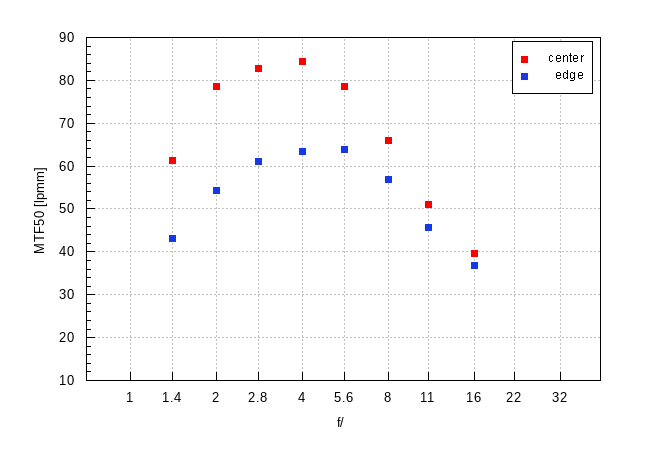OM System M.Zuiko Digital 20 mm f/1.4 PRO
4. Image resolution
Let's check how the tested lens compares – its results in the frame centre and on its edge presents a graph below.

Please Support UsIf you enjoy our reviews and articles, and you want us to continue our work please, support our website by donating through PayPal. The funds are going to be used for paying our editorial team, renting servers, and equipping our testing studio; only that way we will be able to continue providing you interesting content for free. |
- - - - - - - - - - - - - - - - - - - - - - - - - - - - - - - - - - - - - - - - - - - - - - - -
In the frame centre, the lens is able to exceed a level of 60 lpmm already at the maximum relative aperture so you don't have to worry about poor image quality. On stopping down the MTFs only increase, reaching the peak by f/4.0 with a value of almost 85 lpmm. Here you deal with a result that completely befits a good prime instrument.
Still, it's worth mentioning the fact that the OM 1.4/20 lags behind record-breaking results of the Olympus M.Zuiko Digital ED 17 mm f/1.2 PRO. The 17 mm model comes with a better aperture fastness so reaching higher resolution levels was easier in its case. The OM 1.4/20 deals in this category better for a change than the faster and more complex M.Zuiko Digital ED 25 mm f/1.2 PRO.
The situation on the edge of the frame is quite another story. By f/1.4 the result exceeds slightly 43 lpmm so it would be difficult to talk about sensible image quality – it can be achieved only on stopping down the lens to near f/1.8. The resolution on the edge of the frame lags significantly behind the values we saw in the centre, reaching its peak by f/4.0 and f/5.6 with results about 63-64 lpmm.
In this category the OM 1.4/20 is defeated by both Olympus PRO f/1.2 models. To sum up you can say the OM System M.Zuiko Digital 20 mm f/1.4 PRO performed exceedingly well in the frame centre but its edge of the frame left a bit to be desired, especially in the area close to the maximum relative aperture.
At the end of this chapter, traditionally, we presents crops taken from photos our resolution testing chart that were saved as JPEG files along with RAW files we used for the analysis above.
| Olympus E-M5 II, JPEG, f/1.4 |
 |
| Olympus E-M5 II, JPEG, f/4.0 |
 |






